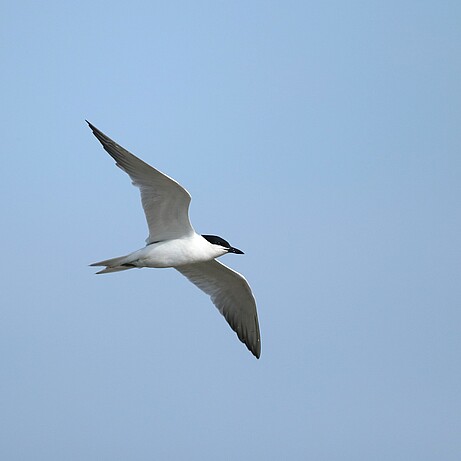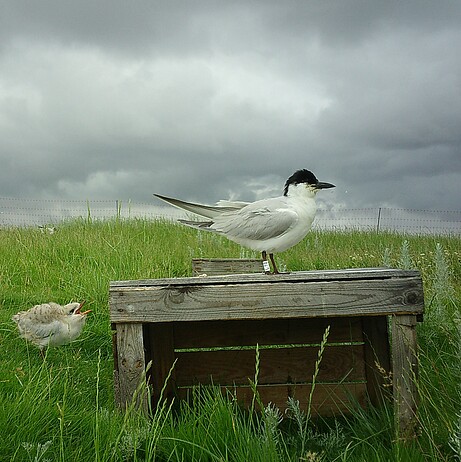

Potential threats to the last gull-billed tern population in Central Europe
Terns, as a group, are primarily piscivorous, meaning fish make up the bulk of their diet. They are known for their distinctive hunting style: hovering over the water and then diving to catch small fish near the surface. This does not hold true for gull-billed terns though, as these birds have a much more varied and terrestrial-based diet. At Neufelderkoog, home to their last Central European breeding colony, and where they have been observed while hunting since 2011, we found the birds to show substantial inter-annual variation in the prey they use. Overall, across all years and reproductive stages, they mostly used crabs, followed by insects, worms, fish, frogs, voles, benthos and birds, respectively (Schnelle et al. 2024a). In terms of threats, this means that the birds rely on various habitats for resource acquisition, and may be affected by problems connected to each of them.
First inventories of levels of pollution showed that mercury levels, often high in other tern species, including the Banter See common terns, were mostly below toxicity thresholds, but that sex-specific accumulation seems to be taking place (Schnelle et al. 2025a). In opportunistically collected unhatched eggs and chicks that died, we assessed the presence and levels of 118 compounds belonging to eight contaminant groups (Schnelle et al. 2025b). Persistent organic pollutants (POPs) were found to be most prevalent (in brain, liver, and the egg content), followed by plasticizers and caffeine (in the eggshell and content). For most of the compounds found, however, we do not yet know at which levels they may become toxic for birds, such that further research is urgently needed to assess whether the observed levels come with consequences for health, reproductive performance or survival. Longitudinal study of adults as well as chicks will be important.
Declining and geographically isolated populations, such as that of the gull-billed terns of Neufelderkoog, often suffer from limited connectivity and reduced gene flow, which may lead to a loss of genetic diversity and inbreeding, and potentially result in local extinction. To address this threat, we first sequenced the complete mitochondrial genome of the gull-billed tern and used it to characterise birds from the declining Neufelderkoog population as well as birds from two thriving Mediterranean populations. We found high genetic diversity in all three populations, but no strong population structure based on breeding location (Schnelle et al. 2024b). The analyses, however, confirm that the German population shows signs of population restriction on the genetic level, while both Mediterranean populations show evidence for population expansion. Current work is focused on expanding our marker-based approach and using whole genome sequencing data to characterize the population structure of contemporary gull-billed terns, while also adding data obtained from samples collected using museum specimens.
Publications
Schnelle A, Peter M, Müller C, Risch M, Liedvogel M*, Bouwhuis S* (2025b) A comprehensive assessment of contaminant exposure in an endangered tern population. Environmental Research 285: 122444 (*shared senior authorship)
Schnelle A, Risch M, Schupp PJ, Liedvogel M*, Bouwhuis S* (2025a) Sex- and age-specific mercury contamination in Central Europe’s last gull-billed tern population. Environmental Pollution 374: 126264 (*shared senior authorship)
Schnelle A, Rollins RE, Cecere JG, Sánchez Gutiérrez J, Masero JA, Risch M, Bouwhuis S*, Liedvogel M* (2024b) Assessment of genetic diversity in a locally endangered tern species suggests population connection instead of isolation. Conservation genetics 25: 1313-1323 (*shared senior authorship)
Schnelle A, Winter M, Bouwhuis S, Risch M (2024a) Diet composition and reproductive performance in Central Europe’s last gull-billed tern population - a long term study. Ardea 112: 247-258

